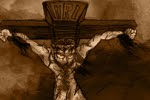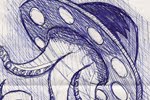Structure:
When you speak about the structure of a robot it is usually mechanical and can be compared with the skeleton of human body. It comprises of links, actuators , and joints which can allow one or more degrees of freedom. Links act as bones and the actuators are responsible for the motion. The development and use of such structures in robots is an active area of research. Robots are also designed as manipulators and they usually have six degrees of freedom and is designed for industrial purpose and they have end effectors . This end effector can be anything from a device to a mechanical hand used to manipulate the environment. These type of Robots are called Industrial Robots.
Actuators:
They are nothing but motors are some kind of devices that help the link move when they are provided with some kind of energy.
Motors: The vast majority of robots use motors and that could be a Dc motor Ac motor or anything. Here are list of Motors and you may get some Idea if you go through that.
Stepper Motors:
Stepper motors are nothing but motors whose mechanical output will be in steps and they do not spin freely like DC motors; they rotate in discrete steps, under the command of a controller. One of the advantages of using Stepper motor is that you can easily determine how far a robot arm has moved and you can have an idea about the position of the End effector without the help of a sensor.
Piezo motors:
These motors are just an alternative to DC motors. Here tiny piezo ceramic materials help to cause motion by vibrating many thousands of times per second, causing linear or rotary motion. There are different mechanisms of operation; for example one type of motors uses the vibration of the piezo elements to walk the motor in a circle or a straight line. In another the piezo elements cause a nut to vibrate and drive a screw. The advantages of these motors are nanometer resolution, speed, and available force for their size.
Air muscles:
There are a simple as well as a powerful device for providing a pulling force. When these are inflated with compressed air, it contracts by up to 40% of its original length. There will be braiding around the outside, which forces the muscle to be either long and thin, or short and fat. Since it behaves in a very similar way to a biological muscle, it can be used to construct robots with a similar muscle/skeleton system to an animal.For example, the Shadow robot hand uses 40 air muscles to power its 24 joints.
Electro polymers:
These are kind of plastics that can expand or get constricted when you apply electrical pulses which can be controlled easily thus controlling the motion. This imitates the human skin in function.
Read more
When you speak about the structure of a robot it is usually mechanical and can be compared with the skeleton of human body. It comprises of links, actuators , and joints which can allow one or more degrees of freedom. Links act as bones and the actuators are responsible for the motion. The development and use of such structures in robots is an active area of research. Robots are also designed as manipulators and they usually have six degrees of freedom and is designed for industrial purpose and they have end effectors . This end effector can be anything from a device to a mechanical hand used to manipulate the environment. These type of Robots are called Industrial Robots.
Actuators:
They are nothing but motors are some kind of devices that help the link move when they are provided with some kind of energy.
Motors: The vast majority of robots use motors and that could be a Dc motor Ac motor or anything. Here are list of Motors and you may get some Idea if you go through that.
Stepper Motors:
Stepper motors are nothing but motors whose mechanical output will be in steps and they do not spin freely like DC motors; they rotate in discrete steps, under the command of a controller. One of the advantages of using Stepper motor is that you can easily determine how far a robot arm has moved and you can have an idea about the position of the End effector without the help of a sensor.
Piezo motors:
These motors are just an alternative to DC motors. Here tiny piezo ceramic materials help to cause motion by vibrating many thousands of times per second, causing linear or rotary motion. There are different mechanisms of operation; for example one type of motors uses the vibration of the piezo elements to walk the motor in a circle or a straight line. In another the piezo elements cause a nut to vibrate and drive a screw. The advantages of these motors are nanometer resolution, speed, and available force for their size.
Air muscles:
There are a simple as well as a powerful device for providing a pulling force. When these are inflated with compressed air, it contracts by up to 40% of its original length. There will be braiding around the outside, which forces the muscle to be either long and thin, or short and fat. Since it behaves in a very similar way to a biological muscle, it can be used to construct robots with a similar muscle/skeleton system to an animal.For example, the Shadow robot hand uses 40 air muscles to power its 24 joints.
Electro polymers:
These are kind of plastics that can expand or get constricted when you apply electrical pulses which can be controlled easily thus controlling the motion. This imitates the human skin in function.











